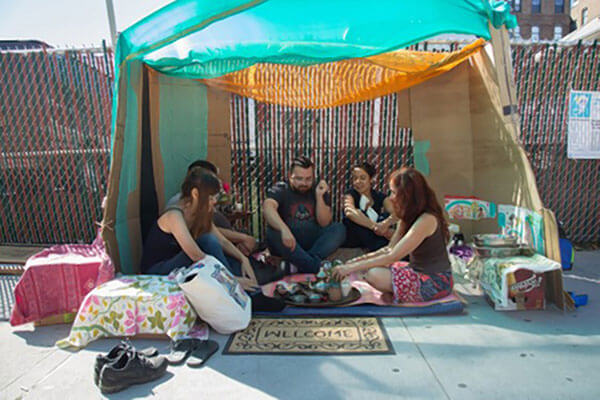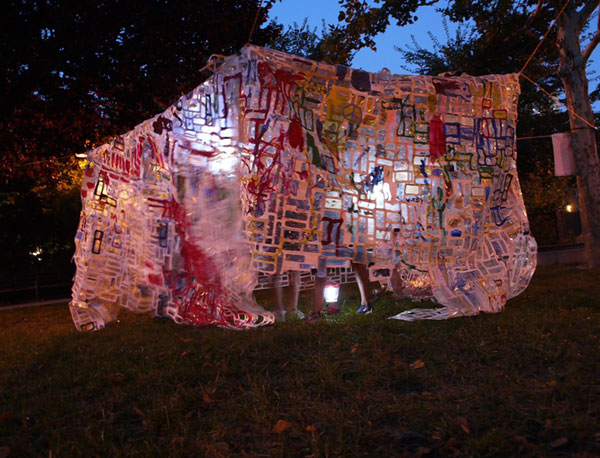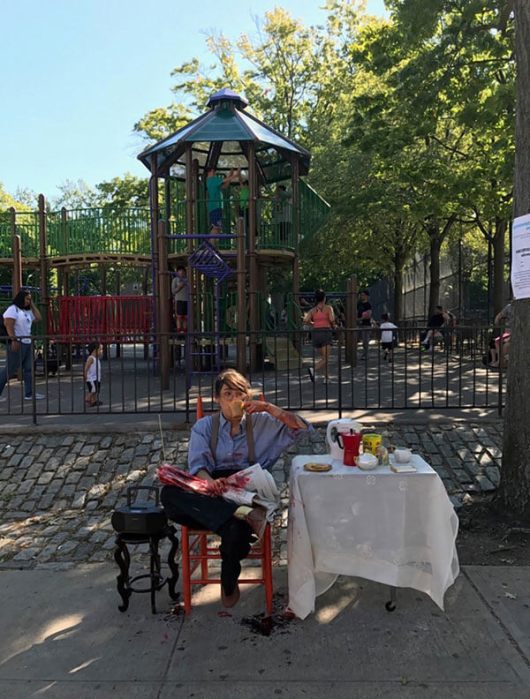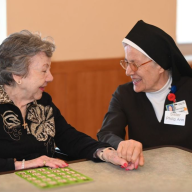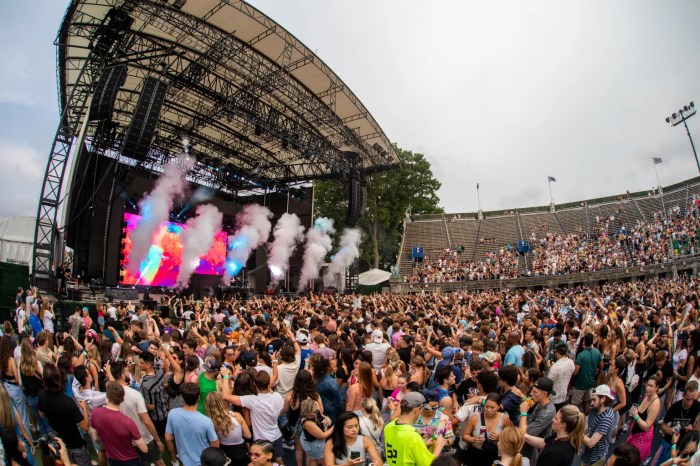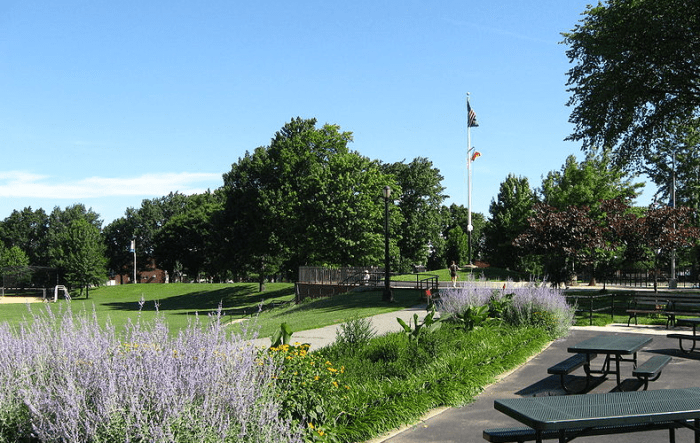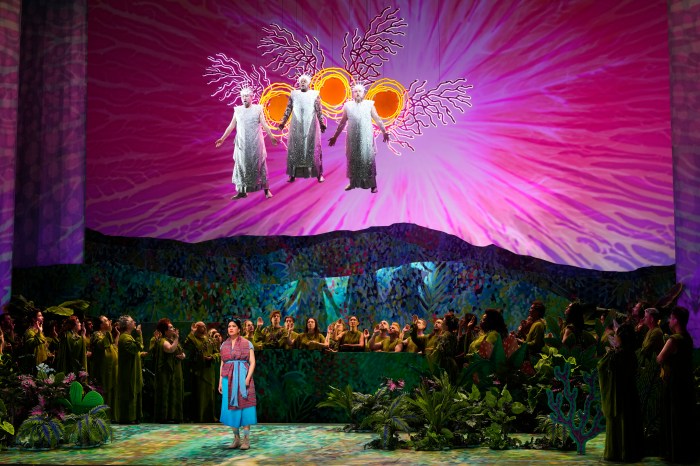By Tammy Scileppi
What is a dwelling?
Ancestral Pueblo peoples considered the cliff dwellings of Mesa Verde (located today at the national park in Colorado) home from about A.D. 550 to 1300. For more than 700 years, they and their descendants lived and flourished there.
Centuries later, global inhabitants dwelled and raised families in tents made from animal skins. As time passed, they were content to call cozy, handmade huts home before learning how to build houses.
Indeed, home is where the heart is. And there are many ways to interpret “Dwelling,” as curious Queens residents happily discovered when they came across unexpected artistic installations that popped up across Long Island City, Astoria, Jackson Heights and Rego Park on a recent Saturday afternoon.
The 4th annual Queens Art Intervention took Queens by storm on Sept. 23, with 12 incredible interventions conceived and presented by 13 neighborhood artists. All focused on an important topic – one that probably resonates with every New Yorker.
Over the past year, local social practice nonprofit RPGA Studio has been investigating what it means to dwell in New York City.
“Because there is so much going on around what we call home (homelessness, refugees, housing, tiny living…), we introduced ‘Dwelling’ as our QAI theme this year,” said RPGA Studio’s founder and executive director Yvonne Shortt, who created this special program.
Well-known for her community-oriented work, Shortt recently organized and took part in the building of a tiny house on wheels, with mostly female volunteers. During QAI Community Engagement Day, folks got a tour of the cozy windowed abode, parked in the driveway of her Rego Park studio. It has a Zen vibe and features a tea table, around which conversations about … yes, dwelling, as well as community issues, are welcomed throughout October.
Beyond that, the house will be transformed every month or two, as its purpose changes, but will always serve the Queens community and remain an incubator for new ideas.
Provocative QAI2017 projects included architectural, art performance, visual and photographic interventions that sparked conversations and encouraged public interaction. Each participant had something to say.
Three of the artists weighed in about their out-of-the-box interventions.
Hiromi Niizeki, Astoria:“Dwelling with Thousands Windows” at Murray Playground, LIC
Thousands of used junk mail envelopes with windows were glued together one-by-one by the artist, a Tokyo native.
For over 20 years, Niizeki has built and exhibited installations in New York City, using discarded materials.
“I did not come to USA for better life, as many other immigrants,” she said. “My parents worked very hard and we lived in a large house, comes with all modern facilities and electronics in suburban Tokyo.
“It looked like a great life, however, our family fell apart.”
This project seemed to symbolize that not all is as it seems. Sometimes, you see people and think, ‘Oh, they’re probably happy and doing very well,’ but if you peer inside their home – through revealing windows – you may find out otherwise.
“I wanted people to stop by my dwell, see it, touch it, enter it, sit inside, try to hear the interesting sound of it, paint on it, add more windows, and think about what ‘Dwell’ means to you,” the artist explained.
After dark, with some small lights up, it was transformed and “became more private inside; whispering voices were too low to understand from outside.”
Domenica Garcia, Jackson Heights: “Corazón Entristecido” at Travers Park, Jackson Heights
This mixed media artist from Ecuador thought up an intriguing, but controversial, performance piece that seemed wrought with social and political innuendo.
“Performing my piece in a public space for the first time was amazing,” Garcia said. “Having the opportunity to watch a personal piece transform into something that now belonged to the public, was memorable.”
“The piece never ceases to remind me that there is no choice but to say goodbye to indifference and to face the tragedies of life with the soul and a sorrowful heart.”
Centered on “Pobre Corazón,” a traditional tune from the Ecuadorian musical genre, Sanjuanito, the intervention was supposed to expose an attitude of indifference towards violence in Latin America and the United States, according to Garcia.
“It juxtaposed elements from both cultures (using iconic props like Café Bustelo, Maria cookies, and The New York Times), creating a parallel between both and ultimately comparing this vast disappointment with a heartbreak,” he said.
Onlookers had mucho questions.
“Many were inquiring what was the specific reason of the blood (on the newspaper),” Garcia said. “Some curiously looked at the pages, hoping to find a specific headline; some thought it was a physical injury because of the blood; others thought it was a lost relationship because of the song choice. The piece has no right answer. It interconnects political, personal and physical pain, allowing the viewer to choose its cause.”
Deborah Wasserman, Jackson Heights: “hos·pi·tal·i·ty” at Roosevelt Avenue
“In my project, I wanted to bring ‘Hospitality’ back to the table, so to speak, calling into question the way we, as individuals, as a community, as a country, welcome others. How do we treat ‘The Stranger,’ ‘The Other’ amongst us?”
Inspired by her Jewish upbringing, rich South American and Middle Eastern background, her life voyages and nomadic history, Wasserman makes personal, visceral, feminist and socially engaged art, centered on her “experiences of being a woman, a migrant, a mother, and a worker in today’s divided, patriarchal society.”
While pondering the idea of bringing people together, “so they can interact with one another in a manner that does not involve commerce or financial exchange, I thought about the ancient tradition of hospitality dating back to the beginning of time,” said the artist.
“Hospitality was practiced as a golden rule; as a shield to protect strangers and travelers from hunger, thirst and potential enemies; a way to practice humility, gratitude and generosity; to straighten relationships in divided communities.”
She said another aspect of her project is the “exploration of class, migration and nomadry. Having spent years in great financial uncertainty, I often contemplate the fate of those less fortunate than me. In a time where natural disaster and warfare produced more migrants and homeless people than I’m able to recall, it’s important for me to contextualize ‘Hospitality’ within the framework of grief and difficulty, so it doesn’t read as an empty slogan, but is rather grounded in today’s reality.”
According to Shortt, from Dec. 13 through Jan. 20, RPGA Studio will be bringing its art installations to the Queens Museum’s community gallery for a QAI Exhibition, “with the hope of inspiring others to create interventions in their communities.”
To see more QAI projects, visit: www.regop
regop

